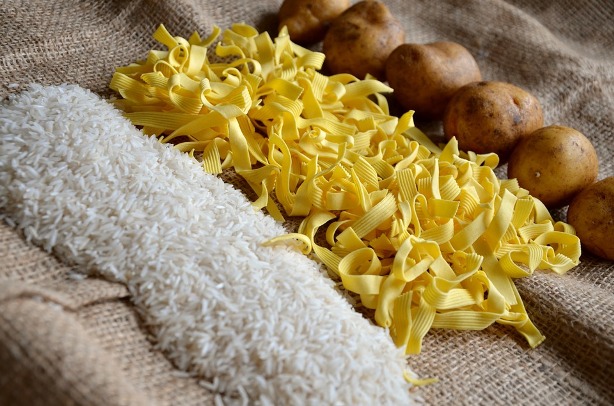
When I turned 30, something switched in my metabolism and I started gaining weight.
Before I realized it, I had gained 20 pounds in a matter of three years. I’m only 5’2″, and this growth spurt was not affecting my height, let me tell you.
Honestly, I had tried everything—from eating low carbs and high protein, to cutting out all alcoholic beverages, to eating gluten-free, to joining an accountability group online. I even joined a “Biggest Loser” contest at work.
Two weeks into the contest, I thought I was doing so well as I hadn’t eaten gluten or indulged in any wine in two weeks. Additionally, I’d been working out consistently. When I hopped on the scale, to my horror, not only had I not lost any weight, I’d gained a pound and one percent body fat.
Something had to give.
About a month and a half ago, I began the vegan lifestyle for the third time in my life, but this time armed with the book, The Starch Solution by Dr. Douglas McDougall, M.D. My friend and health guru, Cheeks, sent it to me in the mail. My aha moment was when I realized it was time to cut out the excess oil and fats from my diet and start eating more starch. I was ecstatic—I love potatoes and rice.
At first, starch consumption seemed so contrary to popular belief and the science I had been reading—especially with regard to weight loss.
It seems that most people I knew who gave up consuming starch and carbs and ate a Paleo diet were losing so much weight.
Despite my doubts, I decided to give The Starch Solution a try. Hesitantly, I ate potatoes and bread: the arch enemies of the modern dieter. What I’m starting to realize now is that it’s not the starch that was adding the pounds, but the dairy, meat, and excess fats (with which starches are often paired).
Surprisingly, after only two weeks of adopting this new lifestyle and way of eating, I was weighed for the aforementioned contest at work, and found that I had lost seven pounds and three percent body fat.
Now, I’m starting to have more energy, and I’m noticing that the bloat that seemed to be perpetually present is starting to disappear. About a month and a half in, I’m down 12 pounds.
Dairy is designed to help baby cows become large adult cows.
According to Dr. Michael Klaper, dairy was never meant for human consumption. Antiquated science said the main source of calcium was dairy. However, this theory has since been proven false. Dairy may help bone density, but it actually increases the risk of fractures. The dairy industry is the one paying for these scientific studies. They sure have a lot of money vested in keeping their product on the market.
Quality, absorbable calcium is found in cruciferous vegetables, including broccoli, spinach, kale, and arugula, and, ironically, calcium supplements can actually do more harm than good.
Check out this video from the documentary, “Cowspiracy” with Dr. Michael Klaper, explaining the dangers of dairy and reasons to avoid it:
Butter and oil are not doing us any favors.
Whole food fats in the form of avocados, almonds, flax seeds, sunflower seeds, and the like are much better for our hearts and overall health at a cellular level. The Mediterranean diet has been touted as a heart-healthy way to eat. This is true in many cases because of the starches that these populations eat, like whole grains, pasta, fruits, and veggies.
Olive oil is also highly present in this culture’s diet, but these people appear to be healthy despite the oil they consume. They’re mainly consuming a plant based, meat-free diet.
“All large populations of trim, healthy people, throughout verifiable history have obtained the bulk of their calories from starch.” ~ Dr. Douglas McDougall
The American Diet consists of 20 percent starch, 70 percent meat and dairy, 5 percent fruits, and 5 percent vegetables, while The Starch Solution consists of 70 percent starch, 0 percent meat and dairy, 10 percent fruits, and 20 percent vegetables. For more rapid weight loss, incorporate 45 percent starch, 0 percent meat and dairy, 10 percent fruits, and 4 percent vegetables.
The populations that have the least cases of obesity, heart disease, and cancers are in Asia and rural Africa where the bulk of their diets are based around starch, vegetables, and fruit. Because we have been so conditioned in the United States to look at the food pyramids—which have been funded by these animal agriculture groups—it may seem contrary to our everyday perception of what is healthy.
“When we switch from the Standard American Diet (S.A.D.) to a starch based diet we increase the fossil fuel availability by 40 fold.” ~ Dr. Douglas McDougall
It is estimated that roughly 16 percent of global warming is is caused by animal agriculture.
This is huge, as transportation exhaust is responsible for only 13 percent of all greenhouse gas emissions. Unfortunately, a leading cause of human-related greenhouse gas emissions is caused by livestock production. Additionally, animal agriculture is also responsible for soil degradation and global deforestation.
Starches and vegetables contain loads of protein and essential amino acids. It is actually a myth that we need animal protein, which is perpetuated by the meat industry. The main source of protein for grazing animals is vegetation. Why can’t humans also go straight to the source to obtain our protein and amino acid needs?
There are better ways to get these necessary building blocks of nutrition in our diets, including eating organic, leafy green vegetables that are rich in absorbable plant proteins, such as amino acids, legumes, nuts, and organic soy. There are also starches that are rich in protein, including but not limited to, yams, brown rice, and sweet potatoes.
As a yogi, one of the yamas or ethical codes is to practice ahimsa or nonviolence to all living beings.
This makes it easier to stay away from meat and dairy products and start eating a starch based diet, especially when we have the right tools needed to succeed. Great cookbooks are vital for a vegan kitchen.
For breakfast, try this oil-free vegan lox and cashew cream cheese recipe that is quickly becoming a staple in my household. For dinner, experiment with this oil-free pesto. And for dessert, consider this vegan, oil-free chocolate cheesecake, which is so good, you’ll wonder if it was actually made using dairy products. Just substitute applesauce for the oil.
There are countless healthy ways to eat in this world. Each of us must find the path that most perfectly works for us.
Personally, I am most happy being a starchivore! Please pass the potatoes.
~
Sources:
he ~
Relephant:
How a High-Carb Diet can Make us Lean & Healthy.
Eat Healthy Carbs To Lose Weight.
~
Author: Claire Nightingale
Image: Centenarian Diet Research/Flickr; Pixabay
Editor: Catherine Monkman






Read 3 comments and reply